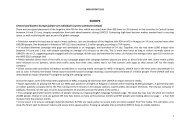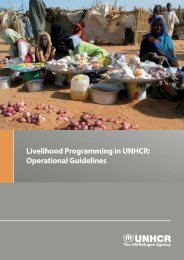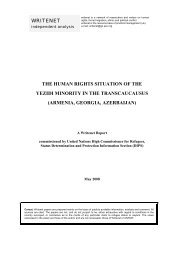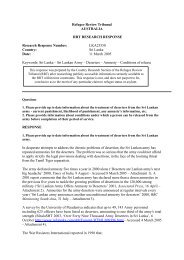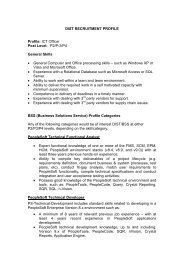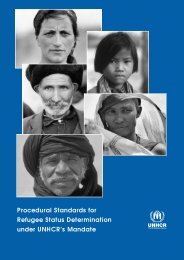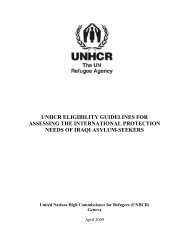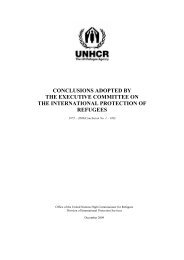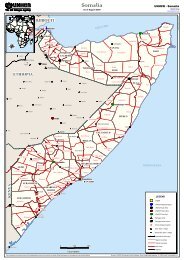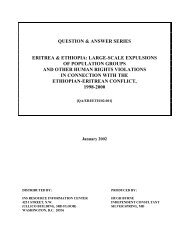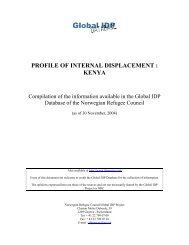UNHCR's ELIGIBILITY GUIDELINES FOR ASSESSING THE ...
UNHCR's ELIGIBILITY GUIDELINES FOR ASSESSING THE ...
UNHCR's ELIGIBILITY GUIDELINES FOR ASSESSING THE ...
You also want an ePaper? Increase the reach of your titles
YUMPU automatically turns print PDFs into web optimized ePapers that Google loves.
“those Iraqis who had lost their nationality pursuant to Law No. (1) Of 1950 and Law No.<br />
(12) Of 1952 cannot have their Iraqi nationality restored as foreseen in Article 18 (I).”<br />
Iraqi legislation regarding the restitution of property confiscated by the former regime<br />
allows for claims regarding property taken by the Ba’ath regime as of 1968, thereby only<br />
applying to a small minority of the Jewish community in exile as nearly all Iraqi Jews left<br />
during the early 1950s. 428<br />
B. Ethnic Groups<br />
1. Kurds, Arabs, Turkmen 429 , Ethnic-Based Christian Groups (Assyrians,<br />
Chaldeans, Armenians) 430 , Yazidis 431 and Shabak 432 in Ethnically Mixed<br />
Areas<br />
a) Introduction<br />
Ethnic tensions and violence are prevalent in traditionally mixed areas in the Governorates<br />
of Kirkuk, Ninewa, Salah Al-Din and Diyala, which have been subjected to the previous<br />
Governments’ Arabization policies. 433 Since 2003, ethnic tensions have flared, mainly in<br />
Kirkuk and Mosul, and in particular before and in the aftermath of significant political<br />
events such as the elections for the TNA and the Governorate Councils in January 2005, the<br />
referendum on the Constitution in October 2005 and the elections for the Council of<br />
Representatives in December 2005. Inter-ethnic tensions among the Kurdish, Arab and<br />
428<br />
The Commission for the Resolution of Real Property Disputes (CRRPD) is not authorized to redress all<br />
wrongdoings related to property by the former governments of Iraq. Rather, the jurisdiction of the CRRPD<br />
runs from 17 July 1968 to 9 April 2003; see Article 4 of Statute of the Commission for the Resolution of Real<br />
Property Disputes, Order No. 2 of 2006.<br />
429<br />
The Turkmen originally came from Central Asia, in a migration that took place over several hundred<br />
years, beginning in the 7 th century AD. The first Turkic people settled in Iraq in the early Islamic era, in the<br />
late 7 th century, and their numbers increased throughout history. Today, they are considered the third largest<br />
ethnic group in Iraq and their number is estimated at 2.5 to 3 million by mainly Turkmen sources, which base<br />
their estimate on an extrapolation from figures from the 1957 Iraqi census. Most international sources indicate<br />
a population of around half a million. Part of the reason for the vast difference in estimates is the former<br />
government’s Arabization policy that forcibly expelled Turkmen from their traditional lands in Iraq and<br />
forced them to register officially as Arabs. The Turkmen of Iraq live mainly in the region stretching from the<br />
Northern town of Tel Afar in Ninewa Governorate to Badra and Al-Aziziyah in Wassit Governorate southeast<br />
of Baghdad. The largest numbers can be found in the Governorate of Kirkuk, with others in Ninewa,<br />
Salah Al-Din, Diyala, Wassit and Baghdad. Also the Northern city of Erbil has a significant Turkmen<br />
population. The Turkmen belong to either the Sunni or the Shi’a faith of Islam.<br />
430<br />
The Assyrians, Chaldeans and Armenians consider themselves as distinct ethnic groups. Assyrians are<br />
united by the Syriac language, their Christian faith and a common cultural heritage of the ancient Assyrian<br />
civilization. The Syriac language is closely related to the Aramaic spoken in ancient Mesopotamia; Chaldeans<br />
and Assyrians share the Syriac language and much of a common history, but were divided by the Chaldeans’<br />
reunification with the Roman Catholic Church in 1552. Today, Assyrians and Chaldeans often consider<br />
themselves as belonging to the same ethno-national group, using the name ChaldoAssyrians, though this is<br />
not undisputed. See, for example, Bet-Nahrain, Petition: The Assyrian (Al-Ashuryeen) is our name, 2003,<br />
http://www.betnahrain.org/petition/assyrian_name.htm. See also “Christians232F”.<br />
431 352F<br />
See also “Yazidis ”.<br />
432<br />
See also “Shabak”.<br />
433<br />
See “De-Arabization”.<br />
87




